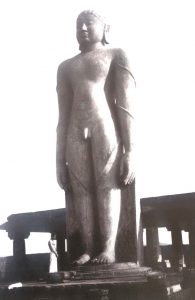Karkala
 Twelve and a half metre high statue of Bahubali. Erected in 1431-32 on a slope of naked rock at the southern outskirts of Karkala, a township famous for its stonemasons. The Chaturmukha (‘four-faced’) basti or basadi (both terms mean tem- ple), built in 1586-87, stands on the same slope.
Twelve and a half metre high statue of Bahubali. Erected in 1431-32 on a slope of naked rock at the southern outskirts of Karkala, a township famous for its stonemasons. The Chaturmukha (‘four-faced’) basti or basadi (both terms mean tem- ple), built in 1586-87, stands on the same slope.
This architecturally important temple is sacred to the Tirthankaras Aranatha, Mallinatha and Munisuvrata who are represented by twelve black-stone images in standing pose and of identical shape and size facing, in four rows of three, the four cardinal points. Six more Jaina temples are found in the Karkala suburb of Hiriyangadi.
A three-kilometre walk through a lush landscape takes one to Karkala’s historic Mangalpada quarry where the craft of giving shape to grey, black and reddish coloured blocks of gneis and granite is still carried on.
In the nineteen-eighties the stonemasons of Karkala were given the task of dressing and sculpturing the statues and masonary parts for a new Buddhist temple in Japan. Before that they sculptured the huge Bahubali now standing on a hill at Dharmasthala
